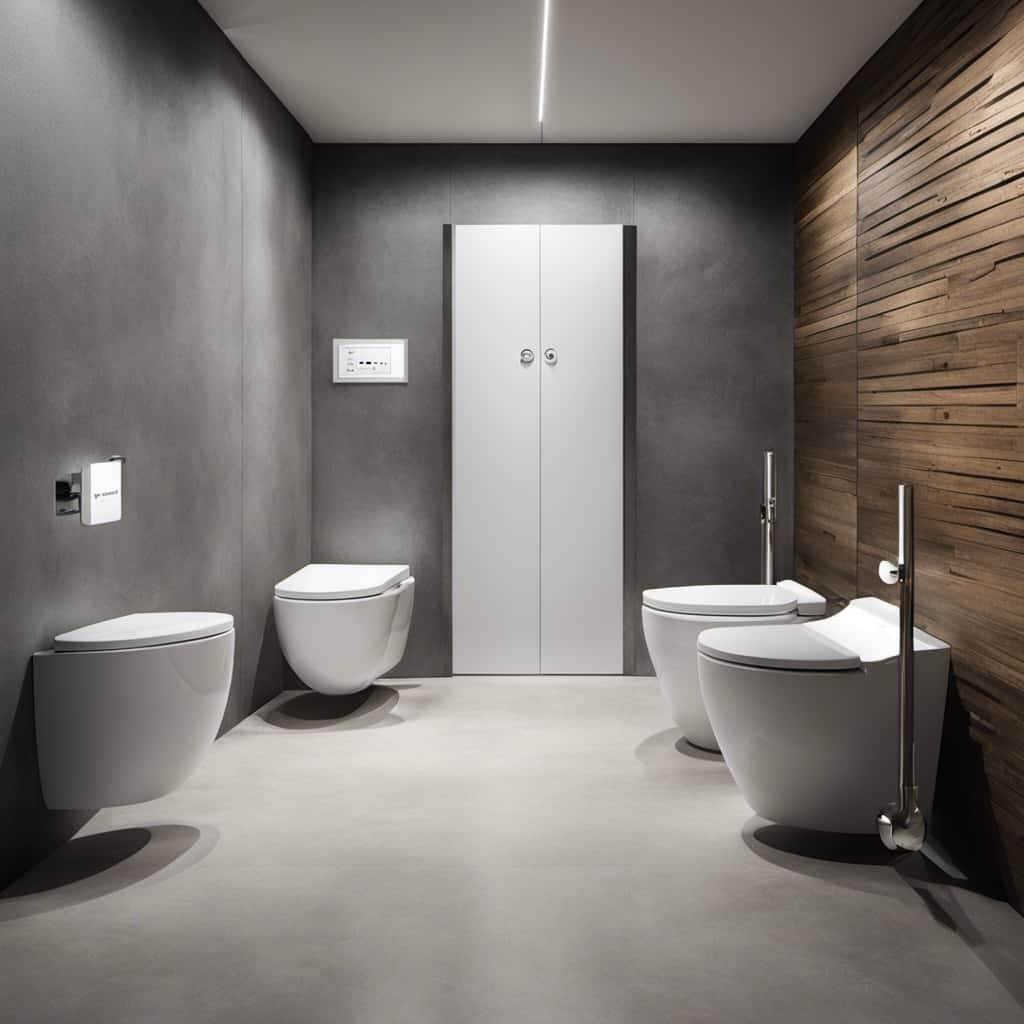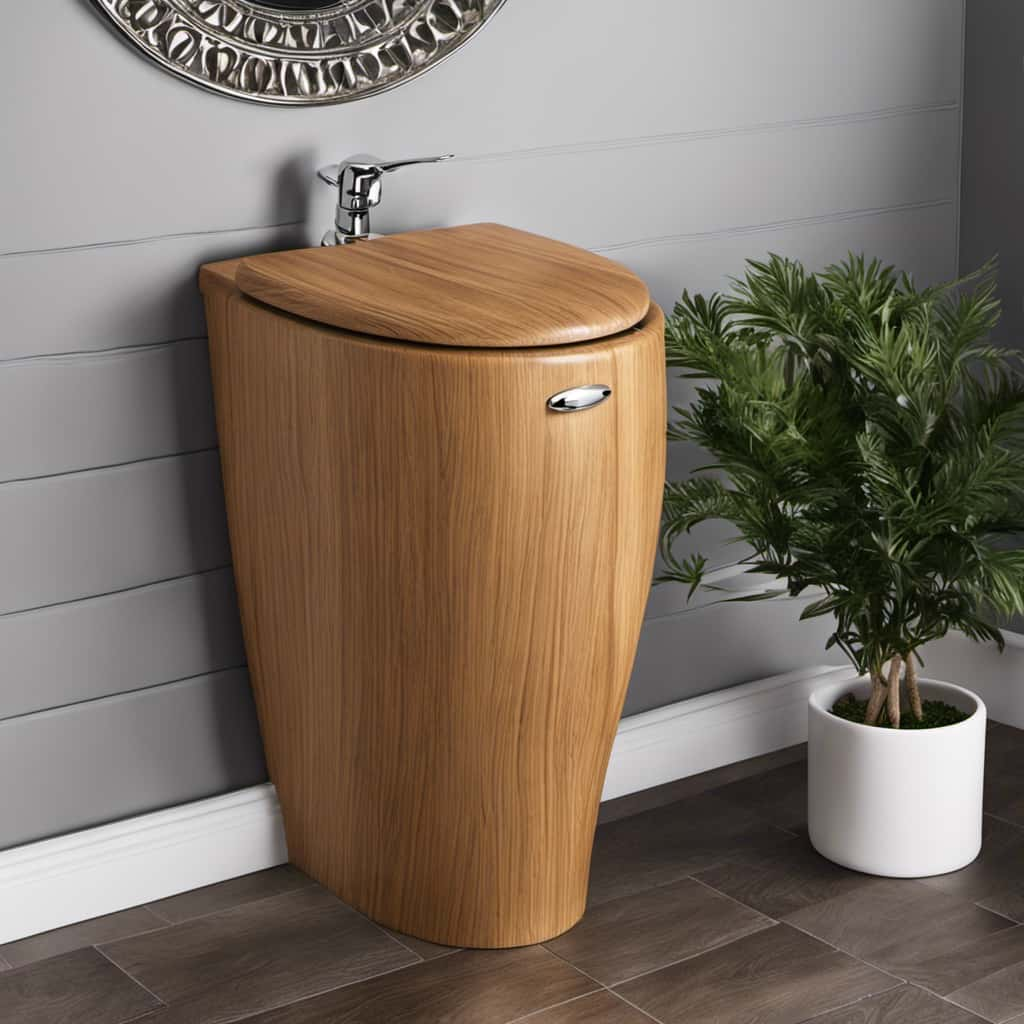We’ve all benefitted from the marvels of modern plumbing, but have you ever wondered how the flush toilet came to be?
Join us on a journey through time as we explore the fascinating history of this essential fixture.
From ancient sanitation practices to the ingenious invention of the S-Trap, and the contributions of Thomas Crapper, we will uncover the evolution and impact of flush toilets.
Get ready to dive into the captivating world of toilet innovation and mastery.

Key Takeaways
- Ancient civilizations had sophisticated sewer systems for waste disposal, demonstrating the importance of waste management and effective water management.
- The S-Trap, invented in the late 18th century, revolutionized sanitation practices by preventing foul odors and providing a more hygienic experience.
- Thomas Crapper made significant contributions to the development and popularization of the modern flush toilet, improving the flushing mechanism and promoting its use.
- Flush toilets have improved sanitation, reduced the spread of diseases, and led to the development of advanced sewer systems. They have also promoted water conservation efforts and enhanced overall quality of life.
Ancient Sanitation Practices
In studying the development of the flush toilet, we explore ancient civilizations’ sanitation practices. Sewer systems and waste disposal were crucial aspects of maintaining cleanliness and hygiene in these societies.
Ancient Egyptians, for example, had intricate sewer systems that utilized gravity to carry waste away from homes and into the Nile River. The Romans, known for their advanced engineering, constructed complex sewer networks, such as the Cloaca Maxima in Rome, which served as a main drainage system.
These early civilizations recognized the importance of waste management and implemented innovative solutions to maintain sanitation. Understanding these ancient practices provides valuable insight into the predecessors of the flush toilet and how they laid the foundation for modern-day sanitation systems.
Predecessors to the Flush Toilet
As we delve into the history of the flush toilet, we can trace its origins back to the predecessors that paved the way for its invention.

Early prototypes of the flush toilet can be found in ancient civilizations such as those of the Indus Valley and ancient Rome. The Indus Valley civilization, dating back to around 2500 BCE, had advanced sanitation systems that included underground drains and toilets connected to a sophisticated sewage system.
Similarly, ancient Rome had a complex network of underground sewage systems called cloacae, which transported waste away from populated areas. These early plumbing systems laid the foundation for the development of the flush toilet, as they demonstrated the importance of proper waste disposal and the need for effective water management.
Without these early predecessors, the invention of the flush toilet as we know it today wouldn’t have been possible.
The Invention of the S-Trap
After exploring the predecessors of the flush toilet, we can now delve into the invention of the S-Trap.

The S-Trap was a significant plumbing advancement that played a crucial role in the development of the modern flush toilet. Invented in the late 18th century, the S-Trap was designed to prevent foul odors from entering the bathroom. Its unique shape allowed for a water seal to be created, effectively blocking the passage of sewer gases.
This invention technique revolutionized sanitation practices, providing a more hygienic and pleasant experience for users. The S-Trap paved the way for further plumbing advancements, leading to the development of the modern toilet as we know it today.
With the introduction of the S-Trap, a new era of improved sanitation began.
Thomas Crapper and the Modern Toilet
We continue our exploration of the invention of the flush toilet by examining the role of Thomas Crapper in developing the modern toilet.

Thomas Crapper was an English plumber and industrialist who made significant contributions to the development and popularization of the modern flush toilet. Contrary to popular belief, Crapper didn’t invent the flush toilet, but he did play a crucial role in its refinement and widespread adoption.
Crapper’s contributions include improvements to the flushing mechanism, such as the ballcock and the siphonic flush system. However, there are many myths and misconceptions surrounding Crapper’s involvement in toilet design, including the belief that he invented the flush toilet or that the slang term ‘crapper’ originated from his name.
These misconceptions have perpetuated over time, adding to the intrigue surrounding Crapper’s legacy.
The Impact and Evolution of Flush Toilets
From our exploration of Thomas Crapper’s contributions to the modern flush toilet, it’s clear that his innovations had a significant impact on the evolution of this essential fixture. The flush toilet revolutionized sanitation practices and had a profound impact on public health.

Here are four key ways in which flush toilets have transformed society:
- Improved sanitation: Flush toilets eliminated the need for manual waste disposal, reducing the spread of diseases and improving overall cleanliness.
- Waste management: The introduction of flush toilets led to the development of advanced sewer systems, effectively managing and disposing of human waste in a more hygienic and efficient manner.
- Water conservation: Technological advancements, such as dual-flush toilets and low-flow systems, have significantly reduced water consumption, promoting sustainability and conservation efforts.
- Comfort and convenience: Flush toilets have provided individuals with a more comfortable and convenient means of relieving themselves, enhancing overall quality of life.
The impact of flush toilets on public health and the continuous technological advancements in this area highlight the importance of this invention in improving our daily lives.
Frequently Asked Questions
What Were the Materials Used to Construct the First Flush Toilets?
The materials used in constructing the first flush toilets were typically porcelain or ceramic for the bowl, iron or brass for the pipes, and wood or metal for the tank. The construction process involved fitting the components together to create a functioning plumbing system.
How Did the Ancient Romans Dispose of Waste Before the Invention of the Flush Toilet?
Ancient Romans used various methods for waste disposal before the invention of the flush toilet. These included public latrines, cesspits, and aqueducts to carry away sewage. Over time, sanitation methods evolved, eventually leading to the development of the flush toilet.

What Were Some Alternative Methods Used for Waste Disposal in Ancient Civilizations?
Ancient civilizations employed various techniques for waste disposal, showcasing the evolution of sanitation practices. From simple pit latrines to complex sewage systems, these methods reflect the ingenuity and resourcefulness of our ancestors.
Were There Any Significant Drawbacks or Limitations to the Early Versions of the Flush Toilet?
There were significant drawbacks and limitations to early versions of the flush toilet. These included issues with water supply, clogging, and the need for frequent maintenance. These limitations hindered widespread adoption and efficiency.
How Did the Introduction of Flush Toilets Affect Public Health and Sanitation Practices in Urban Areas?
The introduction of flush toilets had a significant impact on public health and sanitation practices in urban areas. It revolutionized hygiene practices and led to the development of modern urban infrastructure to accommodate the new system.
Conclusion
In conclusion, the invention of the flush toilet revolutionized sanitation practices and brought about significant improvements in public health and hygiene.

From ancient civilizations’ rudimentary sanitation practices to Thomas Crapper’s contribution to modern toilets, the evolution of flush toilets has been remarkable.
Just like the flush toilet has transformed our lives, it serves as a reminder that even small innovations can have a profound impact on society, making our world a cleaner and more comfortable place to live.










